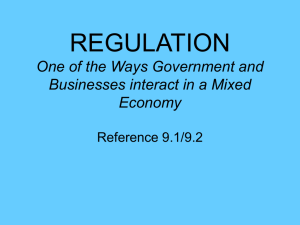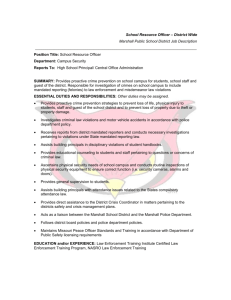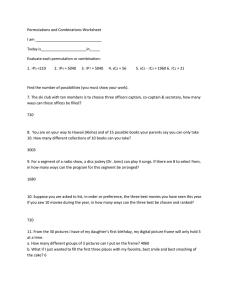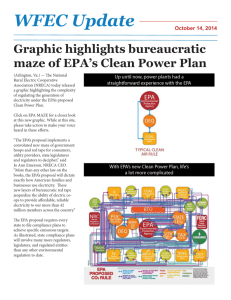T The Causes and Consequences of Industry
advertisement
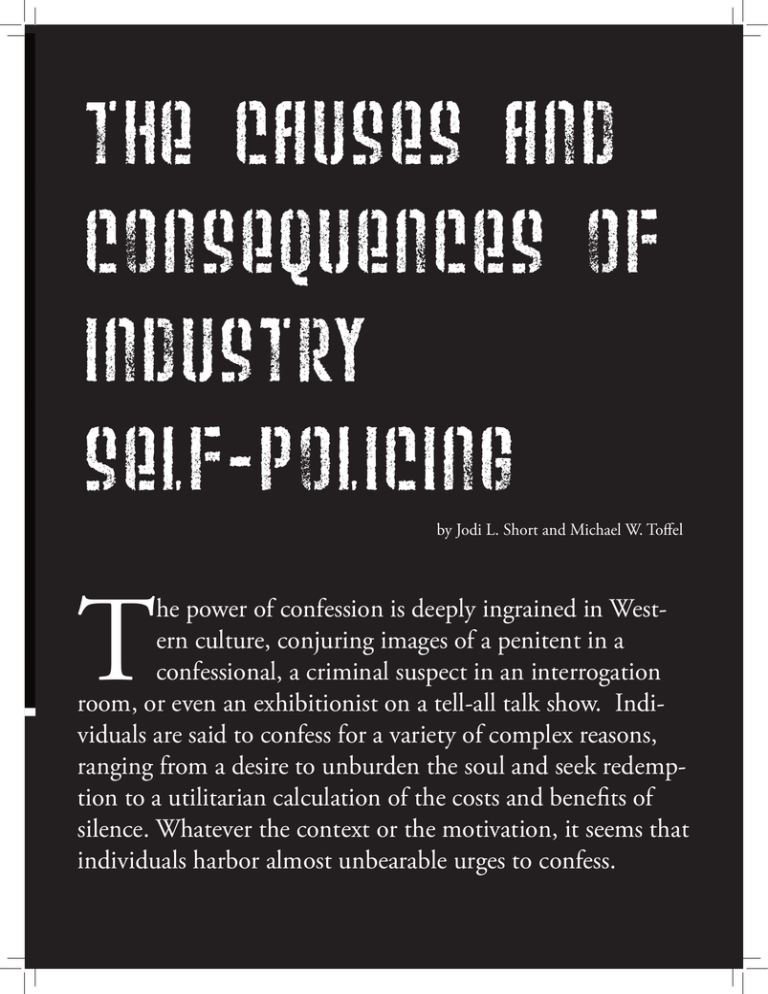
The Causes and Consequences of Industry Self-Policing by Jodi L. Short and Michael W. Toffel T he power of confession is deeply ingrained in Western culture, conjuring images of a penitent in a confessional, a criminal suspect in an interrogation room, or even an exhibitionist on a tell-all talk show. Individuals are said to confess for a variety of complex reasons, ranging from a desire to unburden the soul and seek redemption to a utilitarian calculation of the costs and benefits of silence. Whatever the context or the motivation, it seems that individuals harbor almost unbearable urges to confess. When Self-Policing Fails: The EPA and Regulatory Enforcement by Spencer Allee What happens when firms fail to selfpolice? The EPA is forced to resort to its enforcement policies, which fall into three distinct categories: civil administrative actions, civil judicial actions, and criminal actions. The EPA prefers to avoid involving courts, so in many cases it follows an “Alternative Dispute Resolution” procedure, which uses a third party to help determine an appropriate settlement. Often the terms of a settlement include a Supplemental Environmental Project (SEP), wherein the violator voluntarily agrees to implement an environmentally positive project in a display of good-will. When court action is unavoidable, the EPA might employ a civil judicial action. Here, the U.S. Department of Justice sues the offender on behalf of the EPA. These lawsuits, if successful, lead to civil monetary penalties, injunctive relief (the path back to compliance), SEPs, and even Superfund Penalties, which tack on an extra fee of up to $32,500 for each passing day of non-compliance. Civil penalties are designed to include the value of any economic benefit previously garnered by noncompliance, ensuring that cheaters won’t prosper. The agency reserves its harshest punishments for those who knowingly or willfully violate policy. Criminal punishments given by the courts include the possibility of incarceration in addition to the previously mentioned financial penalties. Moreover, the EPA cooperates with foreign governmental organizations to prosecute international violators such as cruise lines that dump in the ocean, international CFC refrigerant smugglers, and conductors of environmentally unsound operations that occur outside US borders but have wideranging negative externalities. These enforcement policies provide a serious deterrent to corporate violations of EPA regulations. As Short and Toffel point out, many firms would now much rather police internally than find themselves at the agency’s mercy. 34 But what does it mean when a company confesses? A handful of innovative regulatory initiatives seek to harness the power of confession to improve the regulatory compliance of companies. U.S. regulators are devising incentives to get firms to police their own regulatory compliance and to voluntarily disclose, or “confess,” the violations they find. For instance, the Department of Health and Human Services’ Provider Self-Disclosure Protocol offers leniency to health care providers who self-disclose violations of their Medicare and Medicaid obligations. The Department of Defense encourages contractors to voluntarily disclose fraud by granting confessors confidentiality, reduced penalties, and greater control over the ensuing investigation. Similarly, the Antitrust Division of the Justice Department maintains a Corporate Leniency Policy that dramatically reduces and sometimes eliminates penalties for wrongdoers who confess. These kinds of programs, along with other types of voluntary and cooperative regulation initiatives, are becoming increasingly important elements of regulatory strategy. Some evidence suggests that they are beginning to displace traditional regulatory enforcement tools like inspection and prosecution. In her 2005 article on “Interlocking Regulatory and Industrial Relations,” Orly Lobel reported that the Occupational Safety and Health Administration (OSHA) allocates nearly 30% of its budget to “cooperative compliance” programs, while it continues to cut back resources devoted to inspections. The Environmental Protection Agency (EPA) has shifted significant agency staff and budget from core statutory enforcement priorities to some of its flagship voluntary programs, according to Inside EPA Weekly Report. Moreover, a Consumer Reports analysis revealed that the Food and Drug Administration (FDA) conducted half as many inspections of U.S. food manufacturing facilities in 2006 as it did in 2003. Broad governmental and industry enthusiasm for voluntary programs suggests that they will only continue to expand. Given the increased attention on self-regulation more broadly, and self-policing in particular, it is crucial to understand the dynamics of corporate confession. Despite the “win-win” rhetoric, the corporate confession presents something of a behavioral paradox. Tasked with monitoring the legality of its own operations, why would a firm that identifies violations turn itself in to regulators rather than quietly fix the problem? In contrast to criminal cases, where confessions typically occur after a suspect is arrested and charged based on some evidence, most regulatory self-policing programs extend preferential treatment only when the firm’s self-disclosure is entirely voluntary and self-initiated – without any citation, prompting, or other form of notice by regulatory inspectors. Economic intuition would suggest that firms will self-disclose when the cost of doing so is less than the expected cost of hiding violations. The cost of self-disclosing violations is a penalty assigned with certainty, but it is of a magnitude much lower than the maximum penalty possible for the transgression (and sometimes waived entirely). The cost of hiding a violation is much less certain; the risk of detection and the range of penalties vary widely. However, the expected penalty of hiding a violation is remarkably low. Despite the admission by many company environmental managers that the extreme complexity of U.S. environmental regulations results in at least some aspect of their operations always being out of compliance, very few penalties are actually assessed. Our analysis of EPA data reveals that while state and federal inspectors visited and evaluated nearly 40,000 facilities regulated under the Clean Air Act (CAA) between 2001 and 2003—20% of the 200,000 facilities in the EPA’s master database of YALE ECONOMIC REVIEW CAA entities—only 1,200 facilities each year were penalized for violating the statute. Of course, even if few were penalized, the expected value could be substantial if the expected penalty was very high. The median penalty, however, was only $5,600. Given such a low likelihood of detection and such low penalties associated with detected violations, it is not obvious why any firm would voluntarily self-disclose a violation especially since doing so risks impugning its brand reputation, threatens its relations with the surrounding community, and requires it to invest in remediation and systematic compliance monitoring. The regulator’s behavior is also counter-intuitive. Enforcement is a core governmental function that defines the meaning, parameters, and effect of law. It is unclear why regulators would entrust regulated entities with this kind of regulatory power. To explore the complex behavior of corporate self-disclosure, we conducted a large-scale quantitative analysis to identify the causes and consequences of confessing. We investigated what factors led organizations to self-disclose violations that went undiscovered by regulators. We also asked whether these self-disclosing organizations obtained any unofficial regulatory benefits, above and beyond formal penalty mitigation – which, as we discuss above, would not appear to provide significant motivation. Finally, we evaluated whether self-policing promotes the regulatory objective of improving compliance records. We investigated these research questions in the context of the EPA’s Audit Policy. The EPA’s Audit Policy The EPA’s “Incentives for Self-Policing: Discovery, Correction and Prevention of Violations” (Audit Policy) was launched in 1995 to encourage facilities to prevent, detect, and correct regulatory violations by implementing routine, systematic environmental auditing. Under this program, when a facility promptly discloses a violation to the EPA, corrects the violation, and takes steps to prevent future violations, the EPA reduces or waives the punitive portion of the fine that would have accrued. The regulator also provides a loose assurance that it will not refer such voluntarily reported cases to the U.S. Department of Justice for criminal prosecution. Violations that caused “serious actual harm” or that may have presented an “imminent and substantial endangerment” to the public or the environment are not eligible for this relief. According to the data we collected from the EPA through a series of Freedom of Information Act requests, nearly 3,500 facili- ties self-disclosed violations under the Audit Policy between 1997 and 2003. These include “paperwork violations” like failures to report toxic chemical emissions or properly label hazardous materials, as well as violations with more direct environmental consequences, like illegal shipments of hazardous waste to unauthorized facilities and failures to install legally required air pollution control equipment. The Audit Policy is an attempt to change the dynamics of regulatory enforcement. The EPA has expressed hope that self-policing by the private sector will “[render] formal EPA investigation and enforcement action unnecessary.” The agency seeks to achieve this by requiring participating firms to maintain systematic, internal auditing systems to monitor compliance with environmental regulations. While regulators no doubt appreciate the value of discovering disclosed violations, the program’s real leverage lies in its mandate of internal compliance monitoring. For the regulator, the confession is a crucial indicator that internal compliance management structures are working. If it is a reliable indicator, the EPA could reallocate enforcement resources to focus on nondisclosers, who may not be managing their environmental obligations as effectively. Why Do Firms Turn Themselves In? In this section, we describe several factors that encourage companies to confess by self-disclosing regulatory violations. We can gain a deeper understanding of the dynamics of corporate confessions by viewing them in the broader context of corporate compliance. We view voluntary disclosure not as an isolated act, but rather as part of a broader regulatory strategy. Consequently, to understand why firms confess, we look to explanations about why they comply. Specifically, we examine the effect of regulatory enforcement activities and information and compliance assistance on voluntary disclosure. Coercive Enforcement Activities. For decades, legal and economic scholars have based explanations of compliance behavior in deterrence theory, which assumes firms are rational actors that comply with legal directives only to the extent that the costs of expected penalties exceed the benefits of non-compliance. Firms’ compliance behavior is assumed to be influenced both by deterrence measures (e.g., inspections, penalties) they have experienced themselves and those they observe being marshaled against others. The deterrent effect of potential sanctions is often viewed as a Despite the “win-win” rhetoric, the corporate confession presents something of a behavioral paradox. Tasked with monitoring the legality of its own operations, why would a firm that identifies violations turn itself in to regulators rather than quietly fix the problem? YALE ECONOMIC REVIEW function of both their likelihood and their severity. Deterrence theory suggests that enforcement activities by regulators improve compliance because they increase the likelihood that regulators will discover and penalize violations. As such, facilities subjected to more inspections face a higher expected cost of non-compliance. Facilities that regulators have recently cited with violations face an even higher chance of detection, since regulators are known to target such facilities for additional follow-up inspections. Finally, those facilities recently subjected to regulatory enforcement actions may be acutely sensitive to the costs of non-compliance because they have incurred legal costs, paid fines for their non-compliance, and are subject to more severe consequences in the future as “repeat offenders.” We posit that firms facing high levels of regulatory scrutiny will develop strategies to improve not only their compliance but also their standing with the regulator. To deflect regulatory scrutiny, they must convince regulators that such high levels of inspections are not necessary to ensure compliance. One way to do this is by substantially improving internal compliance management systems: bolstering policies and procedures, conducting training, and implementing a routine internal audit system. Over time, regulatory inspectors should observe fewer violations and a more cooperative attitude at such facilities, both of which may prompt the regulator to reduce its scrutiny over such firms. But facilities may be able to accelerate this process—and more rapidly bolster the regulator’s confidence in their willingness to comply—if they take proactive steps to communicate their new compliance posture. Self-disclosing a violation—especially as a result of careful assessments conducted through a routine self-policing program— could be just the ticket if regulators interpret self-disclosing as a credible signal of a facility’s commitment to compliance. Our empirical analysis of thousands of highly regulated facilities across the United States suggests that facilities facing particularly high levels of regulatory scrutiny are indeed significantly more likely to self-disclose compliance violations. Their confessions are, in effect, “coerced.” Our results suggest that an additional inspection increases the probability of self-disclosure the next year by roughly 10 percent. Facilities with particularly poor regulatory relations are often subject to the most intensive regulatory scrutiny and as such have an even greater incentive to convince regulators that they have strengthened their policies and are now more willing and able to comply with regulations. Indeed, our empirical results show that facilities that were subjected to at least one enforcement action were more than twice as likely as other facilities to self-disclose a violation the next year. These results mirror prior studies finding that regulatory activities like inspections and enforcement actions stimulate compliance improvement. We believe that self-policing and compliance respond similarly to these deterrence incentives because participating firms use self-reports as a signal to convey a “pro-compliance” image to regulators. Information and Compliance Assistance. It has long been recognized that firms are more likely to comply with legal requirements if they have knowledge of the applicable law and if they understand what it means to comply. In addition to its more traditional enforcement activities, the EPA sponsors a number of initiatives aimed at educating firms about pressing environmental problems and informing them about the incentives to confess violations. The EPA bi-annually releases information about its enforcement priorities in a document that announces its “National Priority Sectors.” This provides regulated firms and their counsel and consultants with information about the regulatory issues the EPA deems most pressing and the way the agency plans to allocate its enforcement resources. EPA “Compliance Incentive Programs” (CIPs) provide much more targeted and intensive outreach to the regulated community. Through its CIPs, the EPA contacts a target group of facilities, articulates its concerns about a particular environmental issue, educates the facilities about their regulatory obligations, and offers facilities the opportunity to find and self-disclose relevant violations under the Audit Policy. CIPs also typically inform the facility that if it fails to participate, it risks being “targeted for potential enforcement inspections [which] could result in an enforcement action.” In our empirical analysis, we find that these information and outreach efforts are very effective in encouraging facilities to self- Facilities targeted by an EPA Compliance Incentive Program and facilities in the EPA’s National Priority Sectors were significantly more likely to self-disclose violations—in some cases, twenty times more likely than the average facility. This suggests that regulators must devote substantial resources to provide the regulated community with the information and tools necessary to police itself. 36 YALE ECONOMIC REVIEW disclose compliance violations. Facilities targeted by an EPA CIP and facilities in EPA’s National Priority Sectors were significantly more likely to self-disclose violations—in some cases, twenty times more likely than the average facility. This suggests that regulators must devote substantial resources to provide the regulated community with the information and tools necessary to police itself. Because we find that regulatory pressures are significant determinants of facilities’ decisions to self-disclose violations and selfpolice their compliance, it becomes highly questionable whether these facilities will continue to do so after regulators shift their scrutiny to other facilities. Our second empirical analysis investigates this question. The Consequences of Self-Disclosure What happens after a company confesses? We examine two perspectives: first, do firms get any unofficial benefits from selfdisclosing (beyond the promised penalty mitigation for the selfdisclosed violation) and, second, do facilities’ compliance records actually improve after facilities self-disclose violations and promise to engage in ongoing self-policing activities? Inspection Holidays. We posit above that self-disclosure may be part of a broader regulatory strategy to signal a compliant posture to the regulator in an effort to reduce regulatory scrutiny. However, the EPA has, to date, refused to provide assurances that self-policing will result in lower inspection priority. This makes self-disclosure a risky strategy, with potential benefits hinging on how regulators interpret the mixed signals that a confession sends. On the one hand, self-disclosure is a facility’s acknowledgement of wrongdoing and suggests its willingness to reform. On the other hand, self-disclosure reveals the existence of law-breaking that the regulator might not otherwise have perceived. Whether the regulator more heavily emphasizes the former or latter interpretation may hinge on its pre-existing perception of the firm as a “good apple” or a “bad apple.” In our second empirical analysis, we compared the inspection rates of self-disclosers to a matched control group of non-disclosers. We compared how each of these groups’ inspection rates changed from the two-year period preceding the self-disclosure year to the five-year period that followed. We found that self-disYALE ECONOMIC REVIEW closing facilities were subjected to 21% fewer annual inspections, which suggests that regulators do indeed grant so called “inspection holidays” to self-disclosers. While we found that inspection holidays were granted to self-disclosers overall, it is the “good apples”—facilities with clean compliance records during the two years preceding self-disclosure—who drive this result. Facilities with recent compliance problems, by contrast, did not receive any significant reduction in regulatory scrutiny. This suggests that regulators interpret self-disclosures differently depending on the reputation of the facility. Compliance Records. From the regulator’s perspective, the value of effective self-policing is that it aids in the effective allocation of regulatory resources, allowing agencies to shift their attention away from self-regulating firms to firms that are more likely to be recalcitrant violators. Regulatory enforcement is subject to severe budget constraints. “Prime Suspects: The Law-Breaking Polluters America Fails to Inspect,” published in 2000 by the non-profit Environmental Working Group notes that declines in environmental enforcement budgets have led to hundreds of “significant” and “high priority” facilities not being inspected at all during the two-year period they analyzed. EPA’s own “Review of the Compliance Monitoring Strategy” in 1999 noted that “approximately half of the states indicate that their resources are insufficient to meet their inspection commitments,” that severe limitations on agency resources “underscore a need for a targeted approach to inspections,” and that voluntary disclosures can play an important role in developing that approach. However, this strategy depends on the reliability of confessions as a signal of good future behavior. If participating in self-policing programs motivates facilities to initiate or strengthen their internal compliance monitoring system, regulatory inspections following voluntary disclosures should yield fewer violations. One way to analyze whether this is occurring—and thus whether the inspection holidays granted to self-disclosing facilities were warranted—is to assess the compliance records of these facilities, once the inspectors did return. In our empirical analysis, we find strong evidence that facilities’ compliance records improved subsequent to self-disclosure. We found that facilities’ inspections were as much as twice as likely as similarly situated non-disclosers to be “clean” (resulting 39 It remains to be seen whether the resources saved by decreasing scrutiny of self-disclosers are worth the costs of spurring the kind of self-policing that leads to corporate confessions. in no violations being cited) after they self-disclosed. The Importance of Self-Policing Taken together, these findings suggest an important role for self-policing within the context of a broader, deterrence-based regulatory strategy. Our finding that self-disclosers improve their compliance records provides promising evidence that self-policing affects firm behavior and that confessions can serve as reliable indicators of these effects. However, we report these findings with caution and several caveats. First, determining whether a facility is in compliance is highly situational and subjective. In our analysis, we follow the approach typical of the legal empirical literature by measuring compliance as the number of violations cited by regulatory inspectors. We hesitate, however, to make the assumption typical in this literature that compliance records are an unbiased estimate of actual compliance behavior. Instead, we acknowledge that our finding that self-disclosing facilities improved their compliance records may, in part, reflect leniency on the part of inspectors convinced that these facilities are exerting a greater willingness to comply. Indeed, a few qualitative studies have suggested willingness-tocomply is an important determinant in whether inspectors accommodate or “throw the book” at facilities when they observe non-compliance. In contrast, our recent interviews with senior managers of environmental agency inspectors have revealed their strong belief that inspectors are not legally permitted to—and in practice do not—offer such leniency when they observe violations. Nonetheless, we view this debate as an open empirical question. Determining the extent to which self-disclosing facilities subsequently committed fewer violations or were merely cited less often due to inspector goodwill is crucial for assessing the public welfare implications of voluntary compliance initiatives. In addition, it is not at all clear that evidence of improved compliance at a handful of self-disclosing firms is contributing to more effective allocation of resources in the broader regulatory enforcement scheme. First, there appears to be a discrepancy in the way regulators interpret the signal of self-disclosure, with “good apples” earning an inspection holiday for their confessions and “bad apples” receiving no benefit. While our data do not allow us to sort out compliance results for “good” and “bad” apples, this result suggests that heuristic biases created by firm reputation may color regulators’ interpretation of self-disclosures, which would prevent them from rationally assessing the value of the confession as a signal. It seems that the most important use of the signal would be to determine when a “bad apple” turns “good.” 40 It is also important to consider our compliance findings in light of our participation findings, which suggest that traditional regulatory enforcement activities like inspections and prosecutions are key motivators for firms to undertake self-policing. Facilities are more likely to self-report violations after being targeted by frequent inspections and focused compliance initiatives. In fact, self-reporting is encouraged even by ostensibly hostile relations with regulators: facilities that recently experienced enforcement actions, which involve significant legal costs and often result in penalties and injunctive relief, are much more likely to self-disclose than those with fewer compliance problems. This raises questions about the “voluntary” nature of these programs and about how much value they add to a truly robust enforcement system. It remains unclear whether regulatory self-policing programs can live up to the hope of serving as an innovative new partnership approach between business and government, or whether such programs simply offer “old wine in new bottles.” Finally, our findings suggest that corporate confessions do not come cheaply. They are produced by a combination of resourceintensive enforcement activities and outreach to regulated firms. Companies are highly unlikely to disclose violations unless they are aware of the incentives offered for disclosure. Compliance Incentive Programs, which inform facilities individually of their regulatory obligations and opportunities for disclosure are, by far, the most effective tool for increasing the likelihood of confession, but these are costly and time-consuming endeavors. In addition, their effectiveness likely hinges on their highly individualized targeting, which ultimately limits the regulator’s ability to scale this approach. It remains to be seen whether the resources saved by decreasing scrutiny of self-disclosers are worth the costs of spurring the kind of self-policing that leads to corporate confessions. Thus, while self-policing holds some interesting possibilities, it is not the panacea for shrinking regulatory budgets that many have portrayed. In fact, our findings support a regulatory policy that recognizes the ongoing importance of government regulation and regulators to the success of public-private regulatory partnerships. Confession may unburden the soul, but it appears to do little to unburden the budget. Jodi L. Short is an Associate Professor at the Georgetown University Law Center. Michael W. Toffel is an Assistant Professor at the Harvard Business School and a Faculty Fellow of the Harvard Environmental Economics Program. YALE ECONOMIC REVIEW


